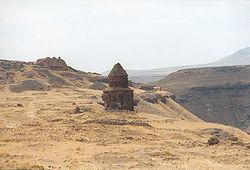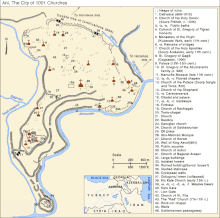Ani (historical city)
| Ani | |
|---|---|
|
UNESCO world heritage |
|

|
|
| Church of Saint Gregory and Citadel |
|
| National territory: |
|
| Type: | Culture |
| Criteria : | ii, iii, iv |
| Reference No .: | 1518 |
| UNESCO region : | Europe and North America |
| History of enrollment | |
| Enrollment: | 2016 ( session 40 ) |
Ani ( Armenian Անի ) is a former Armenian capital that has been abandoned for more than three centuries and is now in ruins .
location
Ani lies in the Turkish-Armenian border area on a plateau ( 1338 m ), surrounded by a deep gorge and the river Achurjan ( poor ) / Arpaçay ( Turkish ) (also Harpasus ), which today forms the border between Turkey and Armenia . Ani is located about 42 kilometers east of the city of Kars in the Turkish province of the same name . The settlement of Anipemza with the early Christian basilica of Jereruk , eight kilometers southeast on the Armenian side, derives its name from Ani.
history
Ani has been an Armenian fortress since the 5th century. In 763 it came into the possession of the Bagratids , in the 10th century it developed into an important city. King Ashot III. Bagratuni (951–977) made Ani the capital of his Armenian kingdom in 961 . When King Gagik II surrendered his empire to the Byzantines in 1045 , Ani, located on the northern Silk Road , was widely known as the “city of 1001 churches” and had a population of more than 100,000. The largest church was the cathedral of Ani , built between 989 and 1001 by the architect Trdat for the Armenian Catholicos transferred to Ani .
On August 16, 1064, after a 25-day siege, Ani was conquered by the Turkish Seljuks , which brought it under Islamic rule. In the course of the conquest, a large part of the population was killed in massacres. Sultan Alp-Arslan left the city in 1072 to the Shaddadids (who already ruled Ganja and Dwin ) , a Kurdish vassal dynasty that stayed here until Ani fell to the Christian kingdom of Georgia at the end of the 12th century . Between 1125 and 1209 they managed to occupy the city five times. The Georgians used the Armenian Zakarids as vassals in Ani, under which the city experienced its last brief heyday. A siege by the Mongols was repulsed in 1226. In 1239, however, Ani fell into Mongolian hands and large parts of the population were killed. In 1319 the fate of the city was sealed by an earthquake, whereupon the population slowly but steadily declined from the 14th century - Ani was now one of the kingdoms of Aq Qoyunlu and Qara Qoyunlu . The city was conquered by Timur in 1380 .
After 1534, Ani was part of the Ottoman Empire and was on the territory of the Russian Empire between 1878 and 1917 .
In 1892/93 and 1904–1917, the first extensive archaeological excavations took place in Ani under the direction of the Russian orientalist Nikolai Jakowlewitsch Marr .
At the end of the First World War , around 6,000 movable archaeological objects were brought from Ani to Yerevan in April 1918 under the direction of the archaeologist Ashkharbek Kalantar , in order to keep them safe from the advancing Ottoman army.
With the surrender of the Ottoman Empire in October 1918, Ani fell under the control of the newly established state of Armenia . After the Turkish-Armenian War of 1920, Ani came to Turkey.
Situation today

Today Ani is a ghost town and is best known for the surviving examples of Armenian architecture . The only "residents" are Turkish border guards , a few tourists and residents of the neighboring Turkish village of Ocaklı.
The future of this cultural monument is threatened by “ restoration work ”, cultural vandalism , earthquakes and, more recently, by ground tremors (triggered by explosions in a quarry on Armenian territory) .
Parts of the double walled city wall, the cathedral (completed in 1001 or 1010), some churches and chapels, the citadel and a palace, which was “rebuilt” at the end of the 20th century , are more or less preserved . The Armenian origin and the Armenian past of the city are, however, concealed by the official Turkish authorities; A notice board only mentions the “Christian heritage within the Ottoman Empire”.
In the past, access to the city was sometimes only possible with a permit, as the area was a restricted military area for a long time. Due to its location directly on the border with Armenia, photography was partially prohibited, and some parts of the area were not accessible to civilians (2001) . In the course of the tourist development, most of the city was made freely accessible. Only the citadel (Turkish: Iç Kale) and the immediate border strip are still restricted military areas and may not be entered.
Several former monasteries around Ani and in the Armenian province of Shirak are stylistically attributed to the architectural "style of Ani" of the 11th century , including Chtsgonk , Marmaschen and Horomos .
From 2012, Ani was on the tentative list for inclusion as a UNESCO World Heritage Site . In 2016 the city was declared a World Heritage Site.
Building (selection)
cathedral
Also known as the Cathedral of the Holy Virgin, the cross-domed Armenian Church is the largest building in Ani. It was built between 989 and 1001/1010 and completed by the architect Trdat . The dome and the drum collapsed in an earthquake in 1319. In another earthquake in 1988, the northwest corner collapsed .
Church of Saint Gregory the King Gagik
This church was probably 1001 to 1005 by the architect Trdat under King Gagik I. built. As a model which at that time already destroyed and also the served St. Gregory consecrated Cathedral of Zvartnots . The church is likely to have collapsed just a few decades after it was built and other buildings were built over it. The remains of the church that are visible today did not come to light until 1906 during the excavations.
Church of the Redeemer
The circular church was built shortly after 1035 to contain a fragment of the true cross . The eastern part collapsed in a storm in 1957. The rest of the building has been in critical condition since the major earthquake in 1988.
Apostle Church
The earliest inscription on the church can be dated to 1031. Only fragments have survived , especially the Shamatun .
Menuçehr Mosque
This mosque is located directly on the slope of the plateau and probably dates from the late 11th century. It was used as a mosque by locals until 1906 and then converted into a museum. The mihrāb in the southern wall was not added until after 1920. The mosque is sometimes called the first mosque in Anatolia , especially by the Turkish side .
Church of Saint Gregory of Tigran Honents
According to the inscription of the founder, this church was commissioned in 1215 by the merchant Tigran Honents. The building is one of the best preserved in Ani. The lush frescoes are unusual for Armenian churches, which is why it is believed that these were made by Georgian painters. The church may have been consecrated to the Georgian Orthodox rite. This is supported by the fact that Ani was under the control of the Kingdom of Georgia at the time of its establishment .
religion
Ani was the seat of the Armenian Catholicos from the 10th century until 1045 .
Others
In 1914, the Russian astronomer Grigori Nikolajewitsch Neuimin named the asteroid (791) Ani after the city.
See also
literature
- Paolo Cuneo and others: Ani (= Documenti di Architettura Armena. 12). Milan 1984.
- Nikolai Marr : Ani. Rêve d'Arménie . Paris 2001, ISBN 2-914571-00-3 .
- S. Peter Cowe (Ed.): Ani. World Architectural Heritage of a Medieval Capital . Peeters, Löwen 2001, ISBN 90-429-1038-0 .
- Ekaterina Pravilova: Contested Ruins: Nationalism, Emotions, and Archeology at Armenian Ani, 1892-1918 . In: Ab Imperio: Studies of New Imperial History and Nationalism in the Post-Soviet Space 1 (2016) 69-101.
Web links
Individual evidence
- ↑ C. Niederl-Garber: The becoming known of the art history of Armenia in the mirror of western travelers. Münster 2013, p. 18.
- ^ R. Panossian: The Armenians: From Kings and Priests to Merchants and Commissars. New York 2006, p. 60.
- ↑ Historic City of Ani. UNESCO
- ^ Archaeological Site of Ani . UNESCO
- ↑ Nina Garsoïan: Mer holer . In: Mélanges Jean-Pierre Mahé (Travaux et mémoires 18). Paris 2014, 372.
Coordinates: 40 ° 30 ' N , 43 ° 34' E






